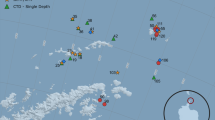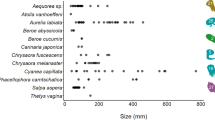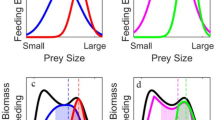Abstract
Feeding dynamics of the Antarctic salps Ihlea racovitzai and Salpa thompsoni were studied in the Lazarev Sea in fall 2004, summer 2005–2006 and winter 2006. Pigment concentrations in the guts of both species were positively correlated with ambient surface chlorophyll a (chl a). No evidence was found for salp clogging even at dense surface concentrations of up to 7 μg chl a L−1. However, gut pigment concentrations had a lower range than ambient pigment concentrations, suggesting that salps increased retention times of ingested material in low-food environments. For medium-sized I. racovitzai and S. thompsoni, estimated individual daily rations reached 7–10 and >100% of body carbon in winter and summer, respectively. Daily respiratory needs of I. racovitzai and S. thompsoni accounted for 28 and 22% of daily carbon assimilation based on pigment ingestion rates in winter, and for 2 and 1% in summer, respectively. The grazing impact of the salp populations on the phytoplankton standing stock was negligible during all seasons due to generally low salp densities. Fatty acid trophic biomarkers in the salps suggest high year-round contributions of flagellates and modest contributions of diatoms to the salp’s diet. These markers showed low seasonal variability for I. racovitzai. The more pronounced seasonality of trophic markers in S. thompsoni were likely related to their generally deeper residence depth in winter linked to a seasonal alternation of sexual and asexual generations.






Similar content being viewed by others
References
Alcaraz M, Saiz E, Fernandez JA, Trepat I, Figueiras F, Calbet A, Bautista B (1998) Antarctic zooplankton metabolism: carbon requirements and ammonium excretion of salps and crustacean zooplankton in the vicinity of the Bransfield Strait during January 1994. J Mar Syst 17:347–359
Andersen V (1985) Filtration and ingestion rates of Salpa fusiformis Cuvier (Tunicata: Thaliacea): effects of size, individual weight and algal concentration. J Exp Mar Biol Ecol 87:13–29
Andersen V (1986) Effect of temperature on the filtration rate and percentage assimilation of Salpa fusiformis Cuvier (Tunicata: Thaliacea). Hydrobiologia 137:135–140
Ashjian CJ, Smith S, Bignami F, Hopkins T, Lane P (1997) Distribution of zooplankton on the Northeast Water polynya during summer 1992. J Mar Syst 10:279–298
Atkinson A, Siegel V, Pakhomov E, Rothery P (2004) Long-term decline in krill stock and increase in salps within the Southern Ocean. Nature 432:100–103
Boysen-Ennen E, Hagen W, Hubold G, Piatkowski U (1991) Zooplankton biomass in the ice-covered Weddell Sea, Antarctica. Mar Biol 111:227–235
Brena C, Cima F, Burighel P (2003) The exceptional “blind” gut of Appendicularia sicula (Appendicularia, Tunicata). Zool Anz 242:169–177
Bruland KW, Silver MW (1981) Sinking rates of fecal pellets from gelatinous zooplankton (salps, pteropods, doliolids). Mar Biol 63:295–300
Casareto BE, Nemoto T (1986) Salps of the Southern Ocean (Australian sector) during the 1983–1984 summer, with special reference to the species Salpa thompsoni, Foxton 1961. Mem Natl Inst Polar Res 40:221–239
Chiba S, Horimoto N, Satoh R, Yamaguchi Y, Ishimaru T (1998) Macrozooplankton distribution around the Antarctic divergence off Wilkes Land in the 1996 austral summer: with reference to high abundance of Salpa thompsoni. Proc NIPR Symp Polar Biol 11:33–50
Cima F, Brena C, Burighel P (2002) Multifarious activities of gut epithelium in an appendicularian (Oikopleura dioica: Tunicata). Mar Biol 141:479–490
Cisewski B, Strass VH, Leach HL (2011) Circulation and transport of water masses in the Lazarev Sea, Antarctica, during summer and winter 2006. Deep-Sea Res I. doi:10.1016/j.dsr.2010.12.001
Conover RJ, Durvasula R, Roy S, Wang R (1986) Probable loss of chlorophyll-derived pigments during passage through the gut. Limnol Oceanogr 31:878–887
Dalsgaard J, John S, Kattner G, Müller-Navarra D, Hagen W (2003) Fatty acid trophic markers in the pelagic environment- a review. Ad Mar Biol 46:227–340
Dubischar CD, Bathmann UV (1997) Grazing impact of copepods and salps on phytoplankton in the Atlantic sector of the Southern Ocean. Deep-Sea Res II 44:415–433
Dubischar CD, Pakhomov EA, von Harbou L, Hunt BPV, Bathmann UV (2011) Salps in the Lazarev Sea, Southern Ocean: II. Morphometrics and Biochemical composition. Mar Biol
Ducklow HW, Fraser W, Karl DM, Quetin LB, Ross RM, Smith RC, Stammerjohn SE, Vernet M, Daniels RM (2006) Water-column processes in the West Antarctic Peninsula and the Ross Sea: Interannual variations and foodweb structure. Deep-Sea Res II 53:834–852
Falk-Petersen S, Hagen W, Kattner G, Clarke A, Sargent JR (2000) Lipids, trophic relationships, and biodiversity in Arctic and Antarctic krill. Can J Fish Aquat Sci 57:178–191
Foxton P (1966) The distribution and life-history of Salpa thompsoni Foxton with observations on a related species, Salpa gerlachei Foxton. Discov Rep 34:1–116
Fukuchi M, Tanimura A, Ohtsuka A (1985) Zooplankton community conditions under sea ice near Syowa Station, Antarctica. Bull Mar Sci 37:518–528
Gleitz M, Bathmann UV, Lochte K (1994) Build-up and decline of summer phytoplankton biomass in the eastern Weddell Sea, Antarctica. Polar Biol 14:413–422
Hagen W (1999) Reproductive strategies and energetic adaptations of polar zooplankton. Invertebr Reprod Dev 36(1–3):25–34
Hagen W (2000) Lipids. In: Harris R, Wiebe P, Lenz J, Skjoldal H, Huntley M (eds) ICES zooplankton methodology manual. Academic Press, London, pp 113–119
Hopkins TL, Lancraft TM, Torres JJ, Donnelly J (1993) Community structure and trophic ecology of zooplankton in the Scotia Sea marginal ice zone in winter (1988). Deep-Sea Res I 40:81–105
Hunt BPV, Hosie GW (2005) Zonal structure of zooplankton communities in the Southern Ocean South of Australia: results from a 2150 km continuous plankton recorder transect. Deep-Sea Res I 52:1241–1271
Hunt BPV, Hosie GW (2006) The seasonal succession of zooplankton in the Southern Ocean south of Australia, part I: The seasonal ice zone. Deep-Sea Res I 53:1182–1202
Ikeda T, Mitchell AW (1982) Oxygen uptake, ammonia excretion and phosphate excretion by krill and other Antarctic zooplankton in relation to their body size and chemical composition. Mar Biol 71:283–298
Ikeda T, Hosie G, Kirkwood J (1984) ADBEX II cruise krill/zooplankton sampling data. ANARE Res Notes 23:1–32
Ju S-J, Harvey HR (2004) Lipids as markers of nutritional condition and diet in the Antarctic krill Euphausia superba and Euphausia crystallorophias during austral winter. Deep-Sea Res II 51:2199–2214
Ju S-J, Scolardi K, Daly KL, Harvey HR (2004) Understanding the trophic role of the Antarctic ctenophore, Callianira antarctica, using lipid biomarkers. Polar Biol 27:782–792
Kattner G, Fricke HSG (1986) Simple gas-liquid chromatographic method for the simultaneous determination of fatty acids and alcohols in wax esters of marine organisms. J Chromatogr A 361:263–268
Kattner G, Hagen W (1995) Polar herbivorous copepods- different pathways in lipid biosynthesis. ICES J Mar Sci 52:329–335
Kattner G, Albers C, Graeve M, Schnack-Schiel SB (2003) Fatty acid and alcohol composition of the small polar copepods, Oithona and Oncaea: indication on feeding modes. Polar Biol 26:666–671
Kawamura A, Michimori K, Moto J (1994) Marked inverse distribution of salps to other macrozooplankton in waters adjacent to the South Shetland Islands. Proc NIPR Symp Polar Biol 7:70–81
Krapp RH, Berge J, Flores H, Gulliksen B, Werner I (2008) Sympagic occurrence of eusirid and lysianassoid amphipods under Antarctic pack ice. Deep-Sea Res II 55:1015–1023
Lancraft TM, Hopkins TL, Torres JJ, Donnelly J (1991) Oceanic micronektonic/macrozooplanktonic community structure and feeding in ice-covered Antarctic waters during the winter (AMERIEZ 1988). Polar Biol 11:157–167
Lee RF, Hagen W, Kattner G (2006) Lipid storage in marine zooplankton—a review. Mar Ecol Prog Ser 307:273–306
Li C, Sun S, Zhang G, Ji P (2001) Summer feeding activities of zooplankton in Prydz Bay, Antarctica. Polar Biol 24:892–900
Lombard F, Renaud F, Sainsbury C, Sciandra A, Gorsky G (2009) Appendicularian ecophysiology I. Food concentration dependent clearance rate, assimilation efficiency, growth and reproduction of Oikopleura dioica. J Mar Syst 78:606–616
Mackas D, Bohrer R (1976) Fluorescence analysis of zooplankton gut contents and an investigation of diel feeding patterns. J Exp Mar Biol Ecol 25:77–85
Madin LP, Deibel D (1998) Feeding and energetics of Thaliacea. In: Bone Q (ed) The biology of pelagic tunicates. Oxford University Press, Oxford, pp 81–103
Madin LP, Kremer P (1995) Determination of the filter-feeding rates of salps (Tunicata, Thaliacea). ICES J Mar Sci 52:583–595
Madin LP, Purcell JE (1992) Feeding, metabolism, and growth of Cyclosalpa bakeri in the subarctic Pacific. Limnol Oceanogr 37:1236–1251
Meyer B (2005) German contribution to SO-GLOBEC: Lazarev Sea Krill study (LAKRIS). GLOBEC Int Newslett 11:46–47
Meyer B, Fuentes V, Guerra C, Schmidt K, Atkinson A, Spahic S, Cisewski B, Freier U, Olariaga A, Bathmann U (2009) Physiology, growth and development of larval krill Euphausia superba in autumn and winter in the Lazarev Sea, Antarctica. Limnol Oceanogr 54:1595–1614
Moline MA, Claustre H, Frazer TK, Schofield O, Vernet M (2004) Alteration of the food web along the Antarctic Peninsula in response to a regional warming trend. Glob Change Biol 10:1973–1980
Nishikawa J, Tsuda A (2001) Feeding of the pelagic tunicate, Salpa thompsoni, on flagellates and size-fractionated chlorophyll particles. Plankton Biol Ecol 48:133–135
Nishikawa J, Naganobu M, Ichii T, Ishii H, Terazaki M, Kawaguchi K (1995) Distribution of salps near the south Shetland Islands during austral summer, 1990–1991 with special reference to krill distribution. Polar Biol 15:31–40
Nöthig E-M, Bathmann U, Jennings JR, Fahrbach E, Gradinger R, Gordon LI, Makarov R (1991) Regional relationships between biological and hydrographical properties in the Weddell Gyre in late austral winter 1989. Mar Chem 35:325–336
Pakhomov EA (2004) Salp/krill interactions in the eastern Atlantic sector of the Southern Ocean. Deep-Sea Res II 51:2645–2660
Pakhomov EA, Froneman PW (2004) Zooplankton dynamics in the eastern Atlantic sector of the Southern Ocean during the austral summer 1997/1998-part 2: Grazing impact. Deep-Sea Res II 51:2617–2631
Pakhomov EA, Froneman PW, Perissinotto R (2002a) Salp/krill interactions in the Southern Ocean: spatial segregation and implications for the carbon flux. Deep-Sea Res II 49:1881–1907
Pakhomov EA, Froneman PW, Wassmann P, Ratkova T, Arashkevich EG (2002b) Contribution of algal sinking and zooplankton grazing to downward flux in the Lazarev Sea (Southern Ocean) during the onset of phytoplankton bloom: a lagrangian study. Mar Ecol Prog Ser 233:73–88
Pakhomov EA, Dubischar CD, Strass V, Brichta M, Bathmann UV (2006) The tunicate Salpa thompsoni ecology in the Southern Ocean. I. Distribution, biomass, demography and feeding ecophysiology. Mar Biol 149:609–623
Pakhomov EA, Dubischar CD, Hunt BPV, Strass V, Cisewski B, Siegel V, von Harbou L, Gurney L, Kitchener J, Bathmann UV (2011) Biology and life cycles of pelagic tunicates in the Lazarev Sea, Southern Ocean. Deep-Sea Res II. doi:10.1016/j.dsr2.2010.11.014
Park C, Wormuth JH (1993) Distribution of Antarctic zooplankton around Elephant Island during the austral summers of 1988, 1989, and 1990. Polar Biol 13:215–225
Pasternak A, Schnack-Schiel SB (2001) Feeding patterns of dominant Antarctic copepods: an interplay of diapause, selectivity, and availability of food. Hydrobiologia 453(454):25–36
Perez FF, Figueiras FG, Ríos AF (1994) Nutrient depletion and particulate matter near the ice-edge in the Weddell Sea. Mar Ecol Prog Ser 112:143–153
Perissinotto R, Pakhomov EA (1998a) Contribution of salps to carbon flux of marginal ice zone of the Lazarev Sea, Southern Ocean. Mar Biol 131:25–32
Perissinotto R, Pakhomov EA (1998b) The trophic role of the tunicate Salpa thompsoni in the Antarctic marine ecosystem. J Mar Syst 17:361–374
Perissinotto R, Mayzaud P, Nichols PD, Labat JP (2007) Grazing by Pyrosoma atlanticum (Tunicata, Thaliacea) in the south Indian Ocean. Mar Ecol Prog Ser 330:1–11
Phillips B, Kremer P, Madin L (2009) Defecation by Salpa thompsoni and its contribution to vertical flux in the Southern Ocean. Mar Biol 156:455–467
Phleger CF, Nelson MM, Mooney B, Nichols PD (2000) Lipids of Antarctic salps and their commensal hyperiid amphipods. Polar Biol 23:329–337
Pond DW, Sargent JR (1998) Lipid composition of the pelagic tunicate Dolioletta gegenbauri (Tunicata, Thaliacea). J Plankton Res 20:169–174
Reinke M (1987) Zur Nahrungs- und Bewegungsphysiologie von Salpa thompsoni und Salpa fusiformis. Rep Polar Res 36:86
Ross RM, Quetin LB, Martinson DG, Iannuzzi RA, Stammerjohn SE, Smith RC (2008) Palmer LTER: patterns of distribution of five dominant zooplankton species in the epipelagic zone west of the Antarctic Peninsula, 1993–2004. Deep-Sea Res II 55:2086–2105
Sargent JR, Bell MV, Bell JG, Henderson RJ, Tocher DR (1995) Origins and functions of n-3 polyunsaturated fatty acids in marine organisms. In: Ceve G, Paltauf F (eds) Phospholipids: characterisation, metabolism and novel biological application. American Oil Chemists’ Society Press, pp 248–257
Schröder M, Fahrbach E (1999) On the structure and transport of the eastern Weddell Sea. Deep-Sea Res II 46:501–527
Scott CL, Kwasniewski S, Falk-Petersen S, Sargent JR (2002) Species differences, origins and functions of fatty alcohols and fatty acids in the wax esters and phospholipids of Calanus hyperboreus, C. glacialis and C. finmarchicus from Arctic waters. Mar Ecol Prog Ser 235:127–134
Siegel V, Piatkowski U (1990) Variability in the macrozooplankton community off the Antarctic Peninsula. Polar Biol 10:373–386
Smetacek V (2001) A watery arms race. Nature 411:745
Smith WO Jr, Codispoti LA, Nelson DM, Manley T, Buskey EJ, Niebauer HJ, Cota GF (1991) Importance of Phaeocystis blooms in the high-latitude ocean carbon cycle. Nature 352:514–516
Spiridonov VA, Nöthig E-M, Schröder M, Wistozki A (1996) The onset of biological winter in the eastern Weddell Gyre (Antarctica) planktonic community. J Mar Sys 9:211–230
Strickland JDH, Parsons TR (1968) A practical handbook of seawater analysis. Bull Fish Res Bd Canada 167:1–311
Sutherland KR, Madin LP, Stocker R (2010) Filtration of submicrometer particles by pelagic tunicates. Proc Natl Acad Sci USA 107:15129–15134
Tanimura A, Kawaguchi S, Oka N, Nishikawa J, Toczko S, Takahashi KT, Terazaki M, Odate T, Fukuchi M, Hosie G (2008) Abundance and grazing impacts of krill, salps and copepods along the 140°E meridian in the Southern Ocean during summer. Antarct Sci 20:365–379
Thurber AR (2007) Diets of Antarctic sponges: links between the pelagic microbial loop and benthic metazoan food web. Mar Ecol Prog Ser 351:77–89
Torres JJ, Lancraft TM, Weigle BL, Hopkins TL, Robison BH (1984) Distribution and abundance of fishes and salps in relation to the marginal ice zone of the Scotia Sea, November and December 1983. Antarct J US 19:117–119
Troedsson C, Grahl-Nielsen O, Thompson EM (2005) Variable fatty acid composition of the pelagic appendicularian Oikopleura dioica in response to dietary quality and quantity. Mar Ecol Prog Ser 289:165–176
Vargas CA, Madin LP (2004) Zooplankton feeding ecology: clearance and ingestion rates of the salps Thalia democratica, Cyclosalpa affinis, and Salpa cylindrica on naturally occurring particles in the Mid-Atlantic Bight. J Plankton Res 26:827–833
Voronina NM (1998) Comparative abundance and distribution of major filter-feeders in the Antarctic pelagic zone. J Mar Syst 17:375–390
Voronina NM, Maslennikov VV, Ratkova T (2005) Changes in the structure of Antarctic plankton in the regions of mass development of salps. Oceanology 45:368–375
Wexels Riser C, Wassmann P, Olli K, Pasternak A, Arashkevich E (2002) Seasonal variation in production, retention and export of zooplankton faecal pellets in the marginal ice zone and central Barents Sea. J Mar Sys 38:175–188
Witek Z, Kittel W, Czykieta H, Zmijewska MI, Presler E (1985) Macrozooplankton in the southern Drake Passage and in the Bransfield Strait during BIOMASS-SIBEX (December 1983–January 1984). Pol Polar Res 6:95–115
Acknowledgments
We would like to thank the captains and crew of RV Polarstern for enabling us to complete our sampling programme, and K. Klinck, G. Schmidt, M. Brenner, L. Gurney, J. Kitchener, L. Würzberg, M. Vortkamp and M. Haraldsson for invaluable assistance in sample collection. We also thank T. Brey for assistance in statistical analyses. Constructive comments on the manuscript were provided by A. Atkinson and two anonymous referees. The surveys were part of the Lazarev Sea Krill Study (LAKRIS) Project, which was funded by the German Ministry of Education and Science (Bundesministerium für Bildung und Forschung, BMBF Forschungsvorhaben, grant number 03F0406A/B). This study was financially supported by the German National Science Foundation (DFG, grant number BA-1508/5-1). An AWI Research stay of E.A.P. was supported by the Alexander von Humboldt Foundation.
Author information
Authors and Affiliations
Corresponding author
Additional information
Communicated by A. Atkinson.
Rights and permissions
About this article
Cite this article
von Harbou, L., Dubischar, C.D., Pakhomov, E.A. et al. Salps in the Lazarev Sea, Southern Ocean: I. Feeding dynamics. Mar Biol 158, 2009–2026 (2011). https://doi.org/10.1007/s00227-011-1709-4
Received:
Accepted:
Published:
Issue Date:
DOI: https://doi.org/10.1007/s00227-011-1709-4




